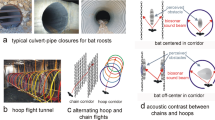Abstract
The orientation behaviour of bats (Phyllostomus discolor, Phyllostomidae), flying inside an octagonal “roost-like” chamber (ø: 100cm; h: 150cm) was examined.
It has been shown that the bats begin turning manoeuvres during flight by turning their head towards the direction they intend to proceed to. During early phases of the flights, cumulative navigation errors were evident, indicating that endogenous spatial information plays a major role in the orientation of the bats. During later phases of the flight this error is diminished again. So it can be concluded that the bats start to use exogenous spatial information for orientation while approaching the target.
In order to investigate the relative importance of vision, echolocation and endogenous spatial information for approaching the roost, the landing lattices inside the test arena were changed for non-grid dummies. We found that: 1. combined visual and endogenous information are more important than echoacoustical cues, 2. the bats learned quickly to switch their orientation behaviour in order to get a better performance in avoiding the dummies, 3. the learning performance was influenced by the visual similarity of dummies and the real landing lattice.
Similar content being viewed by others
References
Barbour RW, Davis WH, Hassell MD (1966) The need of vision in homing by Myotis sodalis. J Mam 47: 356–357
Bradbury JW (1977) Social organization and communication. In: Wimsatt WA (ed) Biology of bats. vol III. Academic Press, New York London, pp 2–72
Bradbury JW, Vehrenkamp SL (1976) Social organization and foraging in emballonurid bats. I. Field studies. Behav Ecol Scociobiol 1: 337–381
Buchler ER, Childs SB (1982) Use of the post-sunset glow as an orientation cue by big brown bats (Eptesicus fuscus). J Mamm 63: 243–247
Chase J (1983) Differential responses to visual and acoustic cues during escape in the bat Anoura geoffroyi: Cue preferences and behaviour. Anim Behav 31: 526–531
Fenton MB, Kunz TH (1977) Movements and behavior. In: Baker RJ, Jones JK Jr., Carter DC (eds) Biology of bats of the New World family Phyllostomatidae. Part II. Spec Publ Museum Texas Tech Univ, Lubbock, pp 351–364
Habersetzer J, Vogler B (1983) Discrimination of surface-structured targets by the echolocating bat Myotis myotis during flight. J Comp Physiol 152: 275–282
Hartley DJ, Suthers RA (1987) The sound emission pattern and the acoustical role of the noseleaf in the echolocating bat, Carollia perspicillata. J Acoust Soc Am 82: 1892–1900
Heblich K (1993) Ortsgedächtnis and Echoortung bei der Großen Huffeisennase. PhD thesis, University of Tübingen
Höller P (1995) A software oscilloscope for Dos-computers with an integrated remote control for a video tape recorder. The assignment of acoustic events to behavioural observations. Comput Methods Programs Biomed 48: 229–235
Höller P, Schmidt U (1993) Olfactory communication in the Lesser Spear-Nosed Bat Phyllostomus discolor (Chiroptera: Phyllostomidae). Z Säugetierk 58 (5): 257–265
Joermann G, Schmidt U, Schmidt C (1988) The mode of orientation during flight and approach to landing in two phyllostomid bats. Ethology 78: 332–340
Kunz TH, August PV, Burnett CD (1983) Harem social organization in cave roosting Artibeus jamaicensis (Chiroptera: Phyllostomidae). Biotropica 15: 133–138
Laska M (1990) Olfactory sensitivity to food odor components in the short-tailed fruit bat, Carollia perspicillata (Phyllostomatidae, Chiroptera). J Comp Physiol A 166: 395–399
McNaughton BL, Chen LL, Markus EJ (1991) “Dead reckoning”, landmark learning, and the sense of direction: a neuro-physiological and computation hypothesis. J Cogn Neurosci 3(2): 190–202
Mistry S (1990) Characteristics of the visual guided response of the Mexican free-tailed bat, Tadarida brasiliensis mexicana. Anim Behav 39: 314–320
Mittelstaedt H, Mittelstaedt ML (1973) Mechanismen der Orientierung ohne richtende Außenreize. Fortschr Zool 21: 46–58
Mittelstaedt H, Mittelstaedt ML (1982) Homing by path integration. In: Papi F, Wallraff HG (eds) Avian navigation. Springer, Berlin Heidelberg New York, pp 290–297
Neuweiler G, Möhres FP (1966) The role of spacial memory in the orientation. In: Busnel RG (ed) Les Systèmes Sonars Animaux in Biologie et Bionique, NATO Advanced Study Institute, Frascati, pp 129–140
Porter FL (1983) Social behavior and allozyme variation in a captive colony of Carollia perspicillata. J Mamm 64 (2): 295–298
Rieger JF, Jakob EM (1988) The use of olfaction in food localization by frugivorous bats. Biotropica 20: 161–164
Rother G, Schmidt U (1982) Der Einfluß visueller Information auf die Echoortung bei Phyllostomus discolor (Chiroptera). Z Säugetierk 47: 324–334
Schmidt S (1988) Evidence for a spectral basis of texture perception in bat sonar. Nature 331: 617–619
Schnitzler HU, Grinnell AD (1977) Directional sensitivity of echolocation in the Horseshoe Bat, Rhinolophus ferrumequinum. I. Directionality of sound emission. J Comp Physiol 116: 51–61
Simmons JA (1979) Perception of echo phase information in bat sonar. Science 204: 1336–1338
Simmons JA, Lavender WA, Lavender BA, Doroshow CA, Kiefer SW, Livingston R, Scallet AC, Crowley DE (1974) Target structure and echo spectral discrimination by echolocating bats. Science 186: 1130–1132
Author information
Authors and Affiliations
Rights and permissions
About this article
Cite this article
Höller, P., Schmidt, U. The orientation behaviour of the lesser spearnosed bat, Phyllostomus discolor (Chiroptera) in a model roost. J Comp Physiol A 179, 245–254 (1996). https://doi.org/10.1007/BF00222791
Accepted:
Issue Date:
DOI: https://doi.org/10.1007/BF00222791




